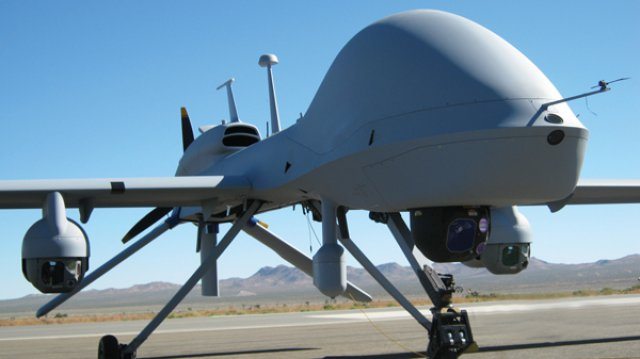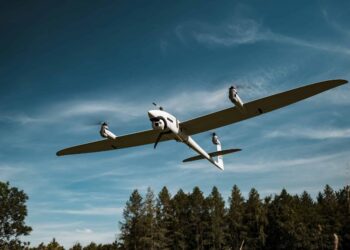The Army’s Program Executive Office for Aviation’s offices Project Manager’s Unmanned Aircraft Systems, PM Armed Scout Helicopter and PM Apache have worked together with the goal to make the most capable, automated, lethal and interoperable systems available to our forward deployed Soldiers and our allies.
On Sept. 16, Program Executive Office for Aviation, or PEO, AVN sponsored the first ever Manned-Unmanned Systems Integration Capability, or MUSIC, Exercise. The exercise was the largest demonstration of manned-unmanned interoperability ever attempted.
The exercise has been in the works for over one and one half years. The integrations and evaluations culminated with a live demonstration before an audience of leaders from across the Department of Defense as well as civilian onlookers.
Tim Owings, deputy program manager for Unmanned Aircraft Systems, or UAS, was a great proponent in bringing this exercise to realization, and had this to say.
“I am most proud of the teamwork and selfless attitudes demonstrated by our industry and government partners,” he said. “You can’t make MUSIC without an orchestra and everyone playing their instruments. This really is an amazing story of teamwork and perseverance.”
There were many objectives to this exercise including: demonstrating advancements made in manned-to-unmanned teaming, or MUM-T; demonstrating interoperability among unmanned systems through the Universal Ground Control Station, known as UGCS, Mini-UGCS, or M-UGCS, and the One System Remote Video Terminal, or OSRVT; and highlighting PEO Aviation’s open architectural approach that allows multiple control nodes and information access points via the Tactical Common Data Link, or TCDL.
The combination of M-UGCS, UGCS and OSRVT serves as the catalyst for interoperability amongst the Army’s manned and unmanned aviation fleet. Interoperability translates into cost savings and increased efficiency through common hardware and software. Interoperability is also helping to mitigate the ever-increasing threat to our Soldiers, due to advancements in enemy technologies, and increasing our Army’s overall combat edge.
“In my short tenure here as the PM, the work I witnessed, day in and day out was brought together and displayed in the first ever MUSIC Exercise,” explained Col. Tim Baxter, with PM-UAS. “Although I had been briefed about this thing called MUSIC, I couldn’t fathom the amount of effort given by each member of PM’s UAS, Apache and Attack Scout Helicopter. The heavy lifting done by a workforce comprised mostly of civilians, and for the good of our Soldiers, is heartfelt and makes a positive impact every day to the lives of those operational folks we send into harm’s way.”
The event established seamless integration of Apache Block II and Kiowa Warrior helicopters, along with the Army’s complete fleet of Unmanned Aircraft Systems, which is comprised of the Raven, Puma, Hunter, Shadow and Gray Eagle.
Video was exchanged flawlessly among all the systems. Additionally, the ability to control the UAS payloads of the larger aircraft from both the M-UGCS and the -OSRVT were demonstrated.
The demonstration clearly illustrated the remarkable capability and synergy that the combination of tightly integrated manned-unmanned systems provides. Furthermore, the demonstration showed clearly how this information could be rapidly provided to individual Soldiers on the ground.
Here is a breakdown of operating systems and technologies explaining desired effects and actual recorded accomplishments.
UNIVERSAL GROUND CONTROL STATION
For the first time the UGCS demonstrated its ability to control the larger unmanned aircraft consecutively from a single ground station through common hardware and software. The results were seen immediately as handoffs occurred between the Shadow Portable GCS, or PGCS, to the UGCS, the Gray Eagle ground station to the UGCS, and finally the Hunter legacy ground station to the UGCS.
This new capability has also paved the way for the universal operator concept. This is a single operator with the ability to fly multiple unmanned aircraft. During the demonstration the same aircraft operator and payload operator flew all three aircraft consecutively marking a huge milestone for UAS.
ONE SYSTEM REMOTE VIDEO TERMINAL
The role of OSRVT was showcased throughout the MUSIC Exercise by demonstrating interoperability with all the participating platforms. OSRVT received the video from the small unmanned aircraft via the Digital Data Link, or DDL. Video from the large platforms was received via TCDL.
The new bi-directional capability in which the OSRVT operator controlled the payloads of the Shadow, Hunter and Gray Eagle platforms demonstrating the ability to receive the video and simultaneously transmit commands back to the aircraft to guide the camera to the point of interest. The combination of the OSRVT and manned aircraft were shown to be able to share targeting data and insure a common operating environment.
All of these capabilities are based on a standard approach so when the OSRVT understands the language of one platform it understands it for all the platforms; enabling efficient use of the available development time. The success demonstrated in the exercise is a direct result of the years of effort spent developing the standards and the hardware and software that implement those standards.
In the coming months these capabilities will be refined to give the Soldier unprecedented situational awareness through an impressive array of tools on the battlefield.
MINI-UNIVERSAL GROUND CONTROL STATION AND GRAY EAGLE UNMANNED AIRCRAFT WITH TRICLOPS PAYLOAD CONFIGURATION
For the Army’s fleet of Small UAS the Army continues to move toward a M-UGCS. For the MUSIC exercise, the M-UGCS Block 0 demonstrated the first step toward that goal. The M-UGCS Block 0 is a software upgrade to the existing Raven GCS, which is currently being fielded by the Army in the thousands.
While this GCS already has the ability to control the Raven and Puma UAS currently being fielded, a software upgrade to the system now allows the GCS to control the wing-mounted sensors on the TRICLOPS configuration of the Gray Eagle. The TRICLOPS configuration adds two additional payloads to the wings of the Gray Eagle in addition to its main payload on the fuselage.
These payloads can be accessed independently of the main payload thus providing the ability to track three geologically separate targets with one air vehicle asset.
The M-UGCS will provide front-line soldiers with Level of Interoperability-, or LOI-, 3 control of highly capable sensors using hardware that is already in place. And in keeping with the nature of true interoperability, the interface follows the same Standardization Agreement 4586 standard as the UGCS for the messaging protocol.
Additionally the audience was able to see the M-UGCS Block 1 on display, which provides the functionality of a Raven GCS in a single, consolidated package. The handheld M-UGCS Block 1 combines the Windows-based functionality of FalconView and video/data logging with the highly-reliable Real-Time Operating System functionality required for real-time UAV control.
Touch screens for ease of use, hot-swap batteries, and a mini-DDL radio also combine to provide a stand-alone package. While still in prototype form, this system is fully functional, and has been evaluated by Raven and Puma operators with a good deal of positive feedback.
MANNED-TO-UNMANNED
AH-64D LONGBOW APACHE
The Apache Block II demonstrated video transmission to the OSRVT via the Efficient TCDL. The TCDL link allows the Apache to send and receive video and metadata. The Apache is currently using the Visual User Interface Tool-, or VUIT-, 2 system in theater with outstanding results. The VUIT-2 system can transmit both Apache and UAS video to the Soldiers on the ground equipped with OSRVT. VUIT-2 provides positive target identification for the Soldier on the ground. Once the target is confirmed, Apache aircrew can engage the target with its weapon systems.
Manned-Unmanned Teaming-2, or MUMT-2, is the next step for Apache. MUMT-2 is a fully compliant TCDL system. MUMT-2 is currently being fielded and provides the Apache an integrated system within the Apache systems architecture. MUMT-2 reduces the weight of the Apache by over 40 LBS while providing all the functionality of the VUIT-2 system.
With MUMT-2 the Apache has the enhanced capability of transmitting both Apache and UAS video to the Soldiers on the ground as well as ship-to-ship. The future for the Apache is Block III. MUMT is a bridging strategy to provide this capability until Block III is fielded. Block III will roll out its first production aircraft in Nov 2011. Block III goes beyond MUMT-2 and VUIT-2 by fully integrating LOI – 4 into the next generation of Apache.
OH-58D – KIOWA
The Kiowa Level 2 Manned-Unmanned, or L2MUM, system succeeded in demonstrating three of its major capabilities that are inherent to this system; a system that is currently in the process of being fielded. The Kiowa Warrior equipped with L2MUM carried out its portion of the MUSIC exercise at a range of 22KM from the OSRVT ground station. The Kiowa L2MUM system successfully received Hunter unmanned aircraft TCDL video and displayed it in the cockpit on the co-pilots multi-function display.
Second, the Kiowa L2MUM system retransmitted the received Hunter video to an OSRVT ground station 22KM away using TCDL. Thus proving out its capabilities to share what the Kiowa pilot is viewing with what the ground OSRVT user is viewing in real-time.
Lastly, the L2MUM system demonstrated its capability to transmit its on-board mast mounted sight video and own-ship metadata to an OSRVT user or other teammates capable of pulling this data into their prevue. Kiowa closed out the demonstration with a live fire of hydra rockets, demonstrating the lethality of these systems when they work together.
Baxter now turns his attention to incorporating the positives discovered during this exercise and refining those areas needing attention.
“As we turn the page on the first ever MUSIC Exercise, I along with the Training and Doctrine Command Capabilities Manager for UAS, must continue to keep pace with combatant commanders increased demands in developing and fielding advanced UAS and personnel to operate these apparatus that change how we fight and win on today’s and tomorrow’s battlefields,” he said.










